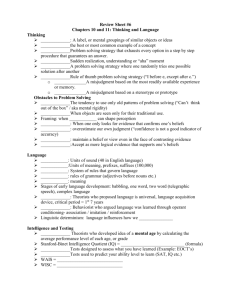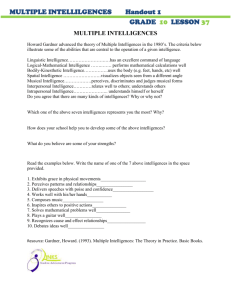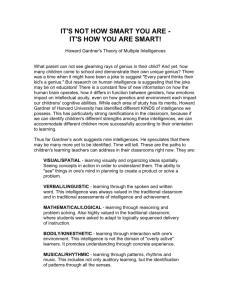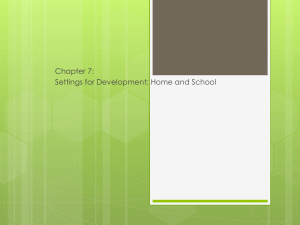Knowing Yourself
advertisement
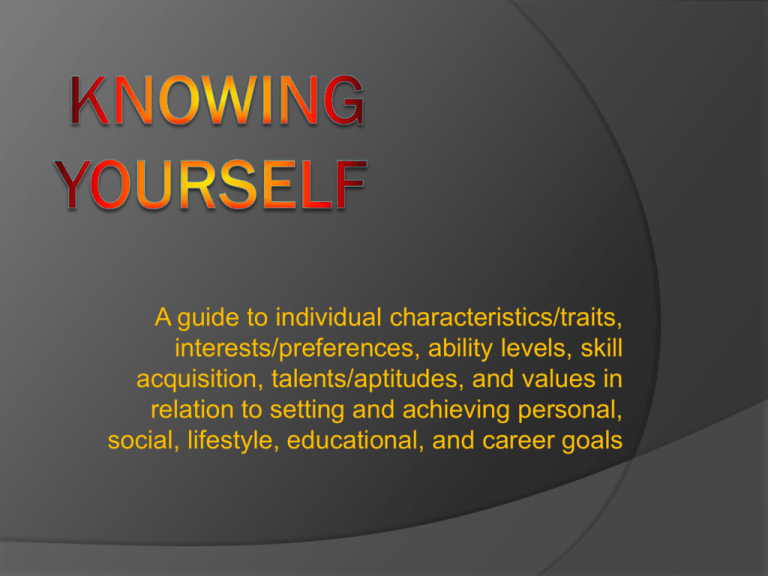
A guide to individual characteristics/traits, interests/preferences, ability levels, skill acquisition, talents/aptitudes, and values in relation to setting and achieving personal, social, lifestyle, educational, and career goals The Scholars Many scholars have studied human behavior over the course of centuries. Some of those studies involve types of behaviors and work personalities. Each person has a different mindset involving work and how to address life’s requirements. See how many of these personality types you can relate to … The Holland Codes Developed by Psychologist John L. Holland, who said: “The choice of a vocation is an expression of personality“ Each person can have any or all of six (6) types of personality interests in a descending order of preference The Holland Hexagon Retrieved from http://en.wikipedia.org/wiki/File:Seriousjobseeker.com_hexagon.gif via http://upload.wikimedia.org/wikipedia/commons/4/41/Seriousjobseeker.com_hexagon.gif Holland’s Personality and Work Environment Types Realistic - practical, physical, hands-on, tool-oriented Investigative - analytical, intellectual, scientific, explorative Artistic - creative, original, independent, chaotic Social - cooperative, supporting, helping, healing/nurturing Enterprising - competitive environments, leadership, persuading Conventional - detail-oriented, organizing, clerical Keirsey Temperament Sorter Artisan: Guardian: Idealist: Rational: “Sensation Seeking”; Concrete communicators, Utilitarian in implementing goals; can become highly skilled in tactile variation. Like arts & crafts, techniques, and operations work. (35-40%) “Security Seeking”; Concrete communicators, Cooperative in implementing goals; can become highly skilled in logistics. Like to supervise, inspect, supply, and protect. Enjoy commerce, regulations, and materials work. (40-45%) “Identity Seeking”; Abstract communicators, Cooperative in implementing goals; can become highly skilled in diplomatic integration. Like teaching, counseling, conferring, and tutoring. Seek humanities, ethics, and personnel work. (8-10%) “Knowledge Seeking”; Abstract communicators, Utilitarian in implementing goals; can become highly skilled in strategic analysis. Planners, organizers, inventors, & engineers. Like sciences, technology, and systems work. (5-7%) Platinum Rule Work Behavior By Dr. Tony Alessandra Director: Relater: Socializer: Thinker: Fast-paced, goal-focused, guarded, & directed. Firm with others; results are the bottom line. May stop listening and become dictatorial under stress. May become too concerned with their personal power. Self-control will increase their effectiveness. Slower-paced, relationship-focused, open and indirect, unassertive, warm, and reliable. Seek security and stability; take action slowly to avoid risky or unknown situations. People (pleasing people) is their primary focus. Dedicated and persistent; “Doers” more than “Thinkers”. Increased interests, assertiveness, and understanding will help them deal with the world more easily. Fast-paced, people-focused, open and direct; animated, intuitive, and lively; spontaneous. Motivated by positive responses from others; loss of recognition triggers humiliation. Emotional & impulsive, avoid conflicts. Control of emotional responses will help them deal with the world better. Slower-paced, task-focused, indirect and guarded. Analytical, persistent problem solvers. Need to be correct & competent; methodical & wellprepared, decide things objectively. Indecisive with new, complex things; fear criticism. Would benefit by collaboration & being less self-critical & demanding. Theory of Multiple Intelligences (Learning Preferences/Multiple Intelligences) Created by Howard Gardner in 1983 Explores various types of intelligence related to learning (people learn in different ways) May best learn given material through alternate approaches May excel in a field outside of a given field, thus appear slower than others May even be looking at the given process at a fundamentally deeper level, which can result in a seeming slowness compared to others Paraphrased from : http://en.wikipedia.org/wiki/Gardner%27s_Theory_of_Multiple_Intelligence Theory of Multiple Intelligences (Learning Preferences/Multiple Intelligences) Spatial: Linguistic: Logical-mathematical: Kinesthetic: Use spatial judgment and the ability to visualize with the mind's eye. Careers include artists, designers and architects. A spatial person is also good with puzzles. Use words, spoken or written. Good with words and languages, reading, writing, telling stories and memorizing words and dates. Learn best by reading, taking notes, listening to lectures, and discussion and debate. Careers include writers, lawyers, policemen, philosophers, journalists, politicians, poets, and teachers. Work with logic, abstractions, reasoning, and numbers. Usually excel in mathematics, chess, computer programming and other logical or numerical activities, with emphasis on reasoning capabilities, abstract patterns of recognition, scientific thinking and investigation, and the ability to perform complex calculations. Matches traditional concepts of "intelligence" or IQ. Careers include scientists, physicists, mathematicians, logicians, engineers, doctors, economists and philosophers. Control bodily motions and handle objects skillfully. Includes a sense of timing, of the goal of a physical action, and the ability to train responses so they become like reflexes. Should learn better by involving muscular movement; good at physical activities such as sports or dance. May enjoy acting and are good at building and making things. They often learn best by doing something physically. If strong bodilykinesthetic intelligence use “muscle memory” - remember things through their body such as remembering words through actions. Careers include athletes, dancers, musicians, actors, surgeons, doctors, builders, police officers, and soldiers. Virtual simulation will not produce the actual physical learning that is needed in this intelligence. Theory of Multiple Intelligences (Learning Preferences/Multiple Intelligences) Musical: Interpersonal: Intrapersonal: Naturalistic: Sensitive to sounds, rhythms, pitch, meter, melody, tones, timbre, and music. People with a high musical intelligence normally have good pitch and can sing, play musical instruments, and compose music. With its strong auditory component, the strongest may learn best via lecture. Language skills are typically highly developed. May use songs or rhythms to learn. Careers include instrumentalists, singers, conductors, disc-jockeys, orators, writers and composers. Interaction with others. In theory, people who have a high interpersonal intelligence tend to be extroverts; sensitive to others' moods, feelings, temperaments and motivations, Can cooperate and work as part of a group. They communicate effectively and empathize easily with others, and may be either leaders or followers. They typically learn best by working with others and often enjoy discussion and debate. Careers include sales, politicians, managers, teachers, and social workers. Introspective and self-reflective. Intuitive and typically introverted. Can understand their own feelings and motivations. Have a deep understanding of the self; strengths/ weaknesses, uniqueness, can predict your own reactions/ emotions. Careers include philosophers, psychologists, theologians, lawyers, and writers. Often prefer to work alone. (added at a later date) Works with nature, nurturing and relating information to one’s natural surroundings. Careers include naturalists, farmers, and gardeners. Type Focus Assessment Sixteen Personality Types Myers-Briggs Type Indicator (MBTI) Created by Katharine Cook Briggs and her daughter, Isabel Briggs Myers Measures psychological preferences in how people perceive the world and make decisions Extrovert v. Introvert (E or I) Sensing v. Intuitive (S or N) Thinking v. Feeling (T or F) Judging v. Perceiving (J or P) ISTJ ISTP ISFJ INFJ INFP INTJ ESTP ESTJ ESFP ENFP ENFJ ENTP ISFP INTP ESFJ ENTJ Learning Styles Auditory Learners Remember what they hear and say Visual Learners Remember what they see Tactile Learners Remember what they experience with their hands or bodies Work Styles Adapted from Carter, Carol, Izumo, Gary, Kravits ,Sarah L., & Reeves, Diane L. (2001). The Career Tool Kit for High School Students: Making the Transition from School to Work. Upper Saddle River, NJ. Prentice Hall. P. 129. The Analyst The Director The Mediator The Entertainer Focus: Tasks in the Workplace The Analyst The Director Acquires & evaluates information Gathers & examines facts—weighs evidence Makes decisions slowly Works carefully Loves stability/low risk taker Dislikes conflict Speaks quietly/firmly Priority: To be the expert Interprets & processes information Acts/produces results Makes decisions easily Works hard Takes risks/challenges stability Thrives on conflict Speaks forcefully Priority: To be in control Timid/Passive Assertive Balanced The Mediator Organizes & Maintains Information Harmonizes workplace Makes decisions reluctantly Works thoroughly Likes stability/rarely bored Can’t stand conflict Speaks supportively Priority: To be needed Bold/Aggressive The Entertainer Communicates information Energizes workplace Makes spur-of-the-moment decisions Works fast Loves risk/easily bored Accepts conflict Speaks spontaneously & well Priority: To be organized Focus: People in the Workplace IQ Test Scores “Intelligence Quotient” Supposed to measure comparative smartness of people 100 = “Average” IQ ½ of the population scores between 90 & 110 25% higher 25% lower Economic and social correlates of IQ IQ <75 75-90 90-110 110-125 >125 US population distribution 5 20 50 20 5 Married by age 30 72 81 81 72 67 Out of labor force more than 1 month out of year (men) 22 19 15 14 10 Unemployed more than 1 month out of year (men) 12 10 7 7 2 Divorced in 5 years 21 22 23 15 9 % of children w/ IQ in bottom decile (mothers) 39 17 6 7 - Had an illegitimate baby (mothers) 32 17 8 4 2 Lives in poverty 30 16 6 3 2 Ever incarcerated (men) 7 7 3 1 0 Chronic welfare recipient (mothers) 31 17 8 2 0 High school dropout 55 35 6 0.4 0 Values are the percentage of each IQ sub-population, among non-Hispanic whites only, fitting each descriptor. Herrnstein & Murray (1994) pp. 171, 158, 163, 174, 230, 180, 132, 194, 247-248, 194, 146 respectively. Line Graph Comparing IQ Scores and the US Population % of US Population 60 50 40 30 % of US Population 20 10 0 <75 75-90 90-110 110-125 >125 Pie Chart Comparing IQ Scores and the US Population % of US Population <75 20 5 5 20 75-90 90-110 110-125 50 >125 BEWARE IQ Test Scores! Interpret IQ Tests with CAUTION! IQ Measures only ACADEMIC intelligence Does not measure or otherwise account for SOCIAL elements, such as home, school, or community Test scores vary even within the same person at different times and on different days IQ Testing should not be the only measurement of a person’s intelligence

